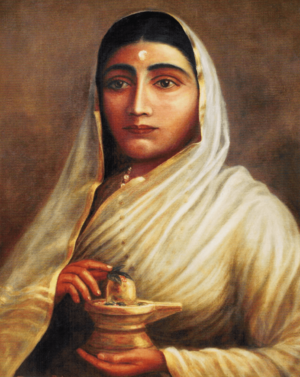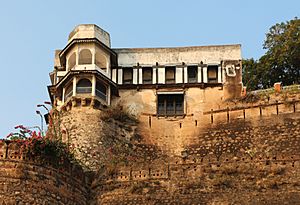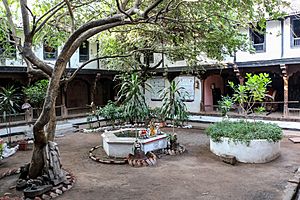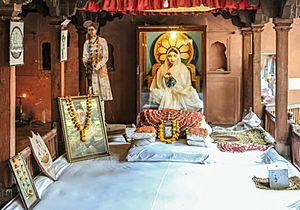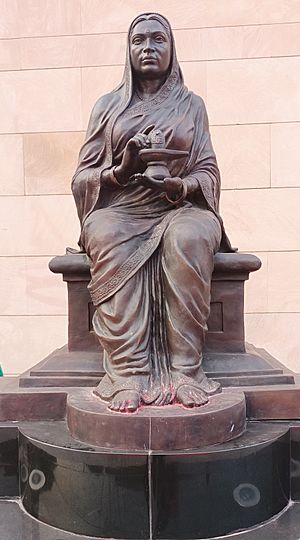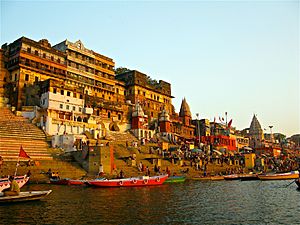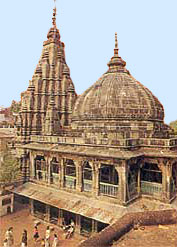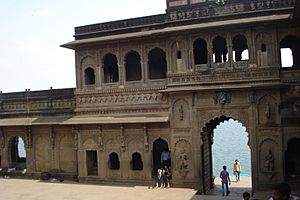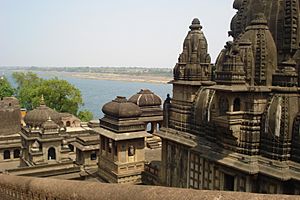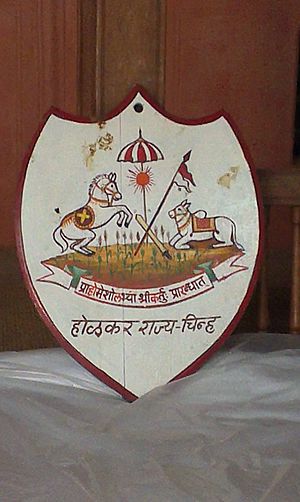Ahilyabai Holkar facts for kids
Quick facts for kids Ahilya Bai Holkar |
|||||
|---|---|---|---|---|---|
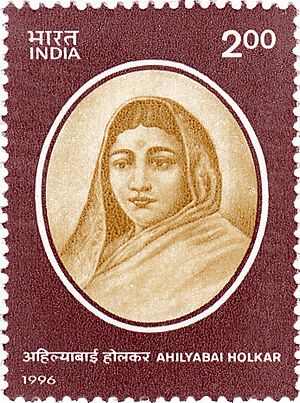
Ahilyabai Holkar on a 1996 Indian stamp
|
|||||
| Reign | 1 December 1767 – 13 August 1795 | ||||
| Coronation | 11 December 1767 | ||||
| Predecessor | Malhar Rao Holkar | ||||
| Successor | Tukoji Rao Holkar | ||||
| Born | 31 May 1725 Chondi, Maratha Empire (present-day Maharashtra, India) |
||||
| Died | 13 August 1795 (aged 70) Indore, Maratha Empire (present-day Madhya Pradesh, India) |
||||
| Spouse | Khande Rao Holkar | ||||
| Issue | Male Rao Holkar (son) Muktabai (daughter) |
||||
|
|||||
| House | House of Holkar | ||||
| Father | Mankoji Shinde | ||||
| Mother | Sushila Shinde | ||||
| Religion | Hinduism | ||||
Ahilya Bai Holkar (born May 31, 1725 – died August 13, 1795) was a powerful queen of the Maratha Empire in old India. She made Maheshwar (in Madhya Pradesh) the main city of the Holkar family.
After her husband, Khande Rao Holkar, and her father-in-law, Malhar Rao Holkar, passed away, Ahilya Bai took charge of the Holkar kingdom. She protected her state, Malwa, from attackers. She even led her armies into battle, with Tukoji Rao Holkar as her main military leader.
Ahilya Bai was famous for building and fixing many Hindu temples and rest-houses (called Dharmashalas) all over India. She is especially remembered for repairing and reopening important holy places that had been damaged or destroyed in earlier times.
Contents
Early Life of Ahilya Bai
Ahilya Bai was born into a Marathi Hindu family. Her parents were Mankoji Shinde and Sushila Shinde. She was born in Chaundi village, which is now in the Ahmednagar district of Maharashtra. Her father, Mankoji Shinde, was a respected village head (Patil). Even though girls usually did not go to school back then, Ahilya's father taught her how to read and write.
A story says that Malhar Rao Holkar, a strong commander in the Maratha army, saw eight-year-old Ahilya at a temple. He was very impressed by her good character. So, he arranged for her to marry his son, Khande Rao, in 1733.
Ahilya often went with Khande Rao on his military trips. Her mother-in-law, Gautama Bai, also helped teach her about managing the kingdom, handling money, and politics.
In 1754, Khande Rao was fighting in a battle at Kumher fort. Sadly, he was hit by a cannonball and died. After her husband's death, Ahilya Bai wanted to perform Sati (a practice where a widow would join her husband on his funeral pyre). However, her father-in-law, Malhar Rao, lovingly convinced her not to. He then trained her further in military matters.
Ahilya Bai's Rule
Becoming the Ruler
After her husband Khande Rao died, Ahilya Bai wanted to give up her life. She planned to perform Sati. But her father-in-law, Malhar Rao, begged her not to. He said she was needed to lead the family and the kingdom.
Malhar Rao Holkar died in 1766. His grandson and Ahilya Bai's only son, Male Rao Holkar, became the ruler. Ahilya Bai helped him govern. But Male Rao also died just a few months later in April 1767. After her son's death, Ahilya Bai became the ruler of Indore.
Ahilya Bai was already well-trained in ruling. She asked the Peshwa (the Maratha leader) Madhav Rao I to officially give her control of the Holkar kingdom. Some people in Malwa did not want a woman to rule. But the Maratha army supported her. The Peshwa agreed on December 11, 1767. He appointed Tukoji Rao Holkar (Malhar Rao's adopted son) as her military chief.
Ahilya Bai ruled Malwa very wisely. She was always available to her people. She would visit her subjects regularly to hear their problems and help them.
Challenges to Her Rule
After her son Male Rao died, a powerful minister named Gangadhar Rao thought Ahilya Bai was a weak widow. He tried to take over the kingdom. He even asked her to adopt him as her son so he could gain power, but she refused.
Gangadhar Rao then encouraged Raghunathrao, an uncle of the Peshwa, to attack Ahilya Bai's kingdom. When Ahilya Bai found out, she quickly sent letters asking for help from her father-in-law's friends, Mahadji Scindia and Damaji Rao Gaekwad. She also gathered her own army with Tukoji's help.
Other Maratha leaders sent their armies to support her. The Peshwa also gave Ahilya Bai permission to fight Raghunathrao. Ahilya Bai herself went to the battlefield with her female bodyguards. Seeing her bravery, Raghunathrao became scared and retreated. He claimed he had only come to offer condolences for her son's death. Gangadhar Rao was put under house arrest but later got his old job back. This event showed everyone Ahilya Bai's strong leadership.
Ahilya Bai also defended her kingdom from raids by the Rajputs.
Building and Progress
Ahilya Bai turned Indore from a small village into a rich and beautiful city. Her own capital, however, was in Maheshwar, a town by the Narmada River. She started many building projects in Malwa. She also supported festivals and gave money for worship in many Hindu temples.
Outside Malwa, she built many Hindu temples, Ghats (steps leading to water bodies), wells, water tanks, and rest-houses across India. These stretched from the Himalayas to holy places in southern India. Some of the places she helped improve include Kashi, Gaya, Somnath, Ayodhya, Mathura, Haridwar, Kanchi, Dwarka, Badrinath Temple, Rameshwaram, and Jagannath Puri.
Ahilya Bai also helped merchants, farmers, and cultivators become successful. She believed their wealth belonged to them, not to the state through high taxes.
There are many stories about how much she cared for her people. For example, when a minister asked for a bribe to allow a child's adoption, she sponsored the child herself.
She also tried to help the Bhils and Gonds, who sometimes raided her borders. She gave them unused hilly lands and the right to collect a small tax on goods passing through their areas.
Ahilya Bai's capital in Maheshwar became a center for art, music, and industry. She supported famous poets and scholars. Artists and sculptors received pay and honors. She even started a textile industry in Maheshwar.
Ahilyabai also changed an old law. This law used to allow the state to take the property of widows who did not have children. She made sure this no longer happened.
Death
Ahilyabai passed away on August 13, 1795, at the age of 70. Her rule is remembered as a golden age in the history of the Maratha Empire. Her commander-in-chief and nephew, Tukoji Rao Holkar, became the ruler after her.
Her Children
Ahilya Bai had a son named Male Rao (born 1745) and a daughter named Muktabai (born 1748). Male Rao became ill and died in 1767. Ahilya Bai married her daughter Muktabai to Yashwant Rao, a brave but poor man, after he successfully fought against robbers.
How People Remember Her

Many people have praised Ahilya Bai Holkar. John Keay called her 'The Philosopher Queen'.
India honored her by issuing a commemorative stamp on August 25, 1996.
The international airport in Indore is named Devi Ahilyabai Holkar Airport in her honor. Also, Indore University is now called Devi Ahilya Vishwavidyalaya.
Structures Built by Ahilya Bai
The Holkar family was known for using their own money for personal expenses, not public funds. Ahilyabai had a lot of personal wealth, which she used for charity.
Ahilyabai paid for the rebuilding of the Kashi Vishwanath Temple in Varanasi in 1780. This temple had been destroyed earlier. She also funded the building of nine other temples, including Shri Tarakeshwar and Shri Gangaji. She helped build and rebuild many Ghats (like Manikarnika Ghat and Dashashwamedh Ghat). She also built rest-houses (Dharmashalas) and gardens in places like Uttarkashi and Rameshwaram.
Images for kids


